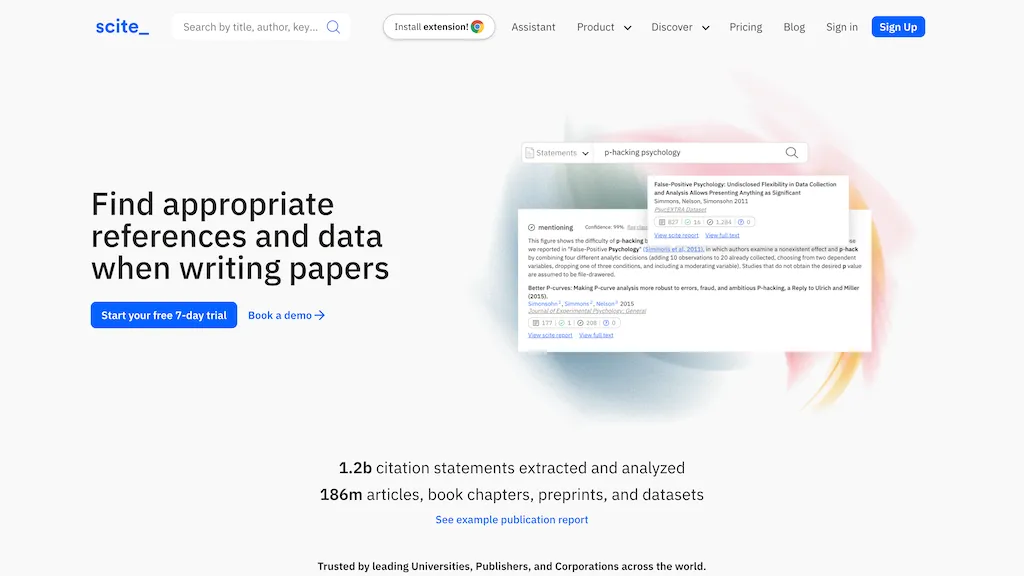What is Scite?
Scite is a brand new smart citation tool that adds significantly more context to conventional citation metrics by categorizing and analyzing citation contexts. This is what allows a user to establish whether an article is supporting or contrasting with a claim. Scite, ultimately, is meant, above all, to help a researcher or student in finding credible and relevant research findings efficiently, keeping track of enhanced research performance, and discovering and evaluating scientific information. The platform also has journal and institute dashboards, research visualizations, and reference checking. Scite has received accolades and various recognitions for being just innovative in changing scientific research for the better.
Features and Benefits of Scite
The features and benefits of Scite are broad so as to meet the needs of multiple users. Some of the key features include:
- It allows for the analysis of citation context to identify evidence type, which can either be supporting or contrasting.
- Better search for relevant and well-supported research results.
- Allow following up and improving research results.
- Easy to search for and evaluate scientific articles.
- Journal and institute dashboards to wrest a full grip on management.
- Good research visualization to understand the citation networks better.
- References check option for better accuracy.
The Pros of Scite
- Higher research efficiency, the ability to quickly find evidence.
- Better academic writing quality with references from evidence.
- Better follow-up and tracking of the impact of the results from the study.
- Automated identification of Maries and Ivans of the high-grade scientific word.
Use Cases and Application of Scite
Scite has vast uses and its applications can be for different purposes. Here are the different applications:
- A researcher finds the supporting or contrasting evidence for a hypothesis quickly.
- A student can enhance the authenticity as well as the refinement of scholarly papers by using Scite. They can add well-supported citations to the paper on the topic.
- Institutes and Journals can make use of Scite’s dashboards for monitoring and enhancing their research outputs.
Scite Benefits Beneficiaries of Scite
- Academic Research
- Education
- Scientific Publishing
- Data Analysis
How to Use Scite
Scite is pretty easy to use. Here is a guide to getting it done:
- Head over to the Scite website and sign up.
- Use the search bar and key in the topic or article area that is of your interest.
- Move over to the citation context to see whether the evidence supports or contrasts.
- Move over to the dashboards to track research outcomes and view citation networks.
- Check over your bibliography to ensure references that are correctly formatted and complete.
It is suggested that users update their search queries at regular intervals in order to get the most out of Scite’s visualization tools to better understand their research topic.
Scite Process
Scite uses the most advanced algorithms and machine learning models for analyzing the different contexts of the citations. The tool classifies whether the evidence cited by text supports, contradicts, or just mentions the research claim based on the citation context. Out of this context, detailed visualizations and dashboards are generated in request to track and improve research outcomes for users.
The Scite process involves:
- Data Collection: The first phase collects citation data from various sources.
- Context Analysis: Context for each citation is derived using NLP.
- Classification: Classification of citation use into supporting, contrasting, and mentioning.
- Visualization: The data is represented in an easily accessible form.
Pros and Cons
Like any other tool, Scite has its own set of pros and cons, including:
Pros:
- Allows a granular insight into the contexts of citations.
- Improves research quality by identifying well-supported evidence.
- Provides full-fledged support for dashboards and visualizations.
- Efficient reference checking.
Cons:
- The interface of the tool might be a bit complicated for beginner users.
- Limits to available data that can be cited.
- Some would find the subscription quite expensive.
Conclusion about Scite
In a word, Scite is a great tool for greatly improving the research process by means of context-based citation analysis. It further distinguishes itself from regular measures and therefore possesses more strength in pulling up leading versus contrasting evidence. Scite is a beautiful research tool that can be a very significant tool for researchers, students, and institutions. Upcoming improvements are likely to further make it an essential scientific research tool.
Scite FAQs
Frequently Asked Questions
Q: How does Scite know if a citation is supporting or contrasting?
A: Scite uses advanced natural language processing algorithms to generate the context within which a citation is made, and then it classifies said citation as supporting, contrasting, or mentioning.
Q: Is Scite free to use?
A: Scite has a free and some premium plans. The free plan includes basic features. The premium plans unlock advanced features and peer comparison through advanced dashboards.
Q: Does Scite integrate with other tools?
A: Yes, Scite integrates with full support for many research management tools and academic writing tools, making research easy and efficient.
Q: Which papers does Scite cover?
A: Scite covers a wide range of articles, including journals, conference papers, and other publications.
Q: How accurate is Scite’s citation analysis?
A: Scite’s algorithms are very precise, but the tool also always improves itself over time, due to the analysis of increasing data and through gathering and considering user feedback.
Q: How do I get started with Scite?
A: All you have to do is visit the Scite website, create an account, and begin exploring your own tools for improving research and citation upload.










